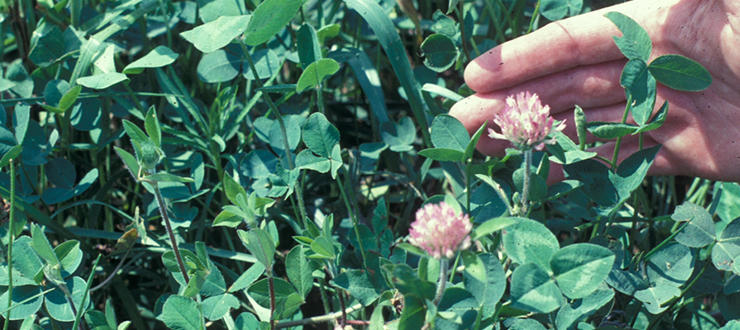
Red Clover: A ‘Work Horse’ Forage Legume

There are several good reasons for growing forage legumes when feasible. These include biological nitrogen fixation, possible extension of the grazing season, increased forage yield (especially compared to grasses receiving little or no nitrogen fertilizer), and improved forage quality.
Factors to consider in selecting a legume to plant can include producer objectives, soil types, sites, and grass species present. No one legume is right for every field or even every farm. Regardless, red clover is a forage legume that is widely adapted in the eastern United States, dependable, easy to grow, and quite productive. “Mammoth” is a one-cut type of red clover grown in the northern US; “medium” is a multi-cut type grown throughout the eastern US. Medium type varieties recently developed in the Deep South are more productive and stress tolerant in the Southeast than varieties developed farther north.
Red clover blooms are actually lavender or reddish-purple in color. Crimson clover, which blooms in early spring and has a much brighter crimson colored bloom, is an annual that can only come back from seed. Red clover is a biennial that can live for two years when planted in a suitable site and managed properly. Red clover normally begins blooming until in April, but may continue to bloom in spring and even early summer.
Red clover can be grown on many soil types as long as the soil pH is around 6.0 to 6.5, the soil is relatively fertile, and a reasonable amount of soil moisture is present during the growing season. Red clover plants will typically live for two years in heavy or moist soils, but in sandy soils in the Deep South, they normally act like an annual.
Red clover is usually grown with a perennial grass, particularly tall fescue, orchardgrass, or dallisgrass. However, because of its upright growth habit, it can be grown as a companion legume in a johnsongrass hayfield or even with bahiagrass or bermudagrass on some sites. It is also sometimes grown with ryegrass or small grain, especially when these forages are being grown for hay or silage. It is not as grazing tolerant as white clover, so should be rotationally grazed to allow the clover plants some rest and to favor good regrowth.
The wide adaptation and excellent seedling vigor of red clover makes it one of the easiest clovers to establish. It is often drilled into thin, weakened, or killed grass sods. In general, rates of 6 to 12 pounds of seed per acre are recommended, and the ideal seeding depth is about ¼ inch. Most commercially available seed of red clover is pre-inoculated. Good seed-soil contact helps ensure establishment, so use of a cultipacker should follow broadcast seeding on a prepared seedbed.
Red clover is most commonly planted in autumn in the Lower South, but if planted in fall in an area where there is a high cricket population, it is advisable to treat with an insecticide. Late winter plantings also may be successful, especially in the mid- and upper South. Regardless of planting date, success is unlikely if the clover is planted into a thick, vigorous perennial grass sod. In such a situation, the grass should be severely suppressed by some combination of heavy grazing, spraying an herbicide, or by tillage. If only a thin stand of grass is present, it may be possible to obtain a stand by simply grazing the grass closely and broadcasting red clover seed, especially if the soil is scratched through use of a drag harrow or similar tool.
Red clover has much to offer. It has the longest growing season of any clover grown in the South, and typically yields more than other clovers. When adequate moisture and nutrients are present, it will often make substantial growth even in June and July. The seed are large enough to easily drill into an existing grass sod, and seedling vigor is good, so plants establish easily. Once established, its upright growth habit enables it to compete with grasses better than most clovers.
Red clover is a particularly good legume companion species in fields to be cut for hay, or in rotationally grazed pastures where late spring and summer growth is desired. This clover is a work horse, and it needs to be used more widely.
__________________
Foraging Ahead is a column presented by Reagan & Massey and written by Dr. Don Ball, Professor Emeritus at Auburn University. Dr. Ball is one of the authors of the popular book “Southern Forages.”